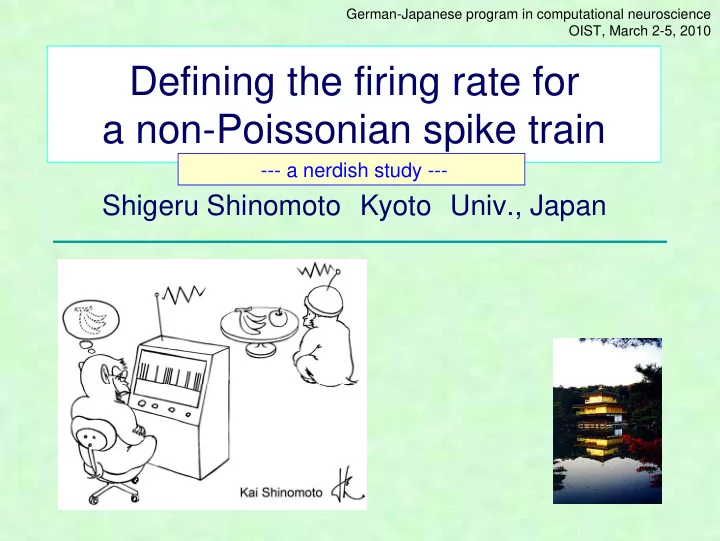

German-Japanese program in computational neuroscience OIST, March 2-5, 2010 Defining the firing rate for a non-Poissonian spike train --- a nerdish study --- Shigeru Shinomoto Kyoto Univ., Japan
A message from a neuron We have established several methods for optimizing rate estimators: 1.PSTH --- 2007 2.Kernel smoother --- 2010 3.Bayesian inference --- 2005, 2009 2
PSTH Spike Sequences number of spikes / binsize PSTH Peri-Stimulus Time Histogram Time dependence may be depicted. But… Multiple interpretations: Which is a likely 3 3 message ?
Optimizing time histograms Hideaki Shimazaki Mean Integrated Squared Error underlying rate ( ) dt 2 1 ∫ T = λ − λ ˆ MISE t t T 0 spike data rigorous inference PSTH 1 PSTH 2 PSTH 3 Shimazaki and Shinomoto, Neural Comput. (2007) 19: 1503-1527. 4
RECIPE Rule is simple: Shimazaki and Shinomoto, Neural Comput. (2007) 19: 1503-1527. 5
Kernel optimization Hideaki Shimazaki better 6 Shimazaki and Shinomoto, J. Comput Neurosci (2010) 29:171-182.
RECIPE Rule is fairly simple: Most downloaded articles in 90 days (Mar. 3, 2011) 7 Shimazaki and Shinomoto, J. Comput Neurosci (2010) 29:171-182.
Bayesian inference Takeaki Shimokawa Rate Spikes Inverse probability = Bayes Shimokawa & Shinomoto, Neural Computation (2009) 21:1931-1951. 8
Poissonian assumption poisson Well done! Our rate estimation algorithms are derived rigorously. However, they are all based on Poissonian assumption. We should test Poissonian. But how can we do it? 9
Capture non-Poissonian How do we test Poissonian? Rescale the time axis! Bermann (1982) Ogata (1988) ~ seismology Reich, Victor & Knight (1998) Oram, Wiener, Lestienne & Richmond (1999) Barbieri, Quirk, Frank, Wilson & Brown (2001) Smith & Brown (2003) Koyama & Shinomoto (2005) Shimokawa & Shinomoto (2009) Shimokawa, Koyama & Shinomoto (2010) 10
How to Estimate non-Poisson feature (1) Conjecture a time-dependent rate. (2) Rescale the time axis with this rate. Non Non-Poisson: regular (3) Conjecture an inter-spike interval distribution. (4) Estimate the likelihood. Repeat (1) - (4) to search for the maximum likelihood. >>> Obtain (non-Poisson feature & rate revised). Poisson: random Non-Poisson: bursty 11
Bayesian interpretations Shinsuke Koyama marginal likelihood For a single spike train, two interpretations arise. ~ irregularly derived from a constant rate Irregular intervals ~ regularly derived from a fluctuating rate Regular intervals One interpretation is selected according to statistical plausibility. Koyama & Shinomoto, J. Phys. A (2005) 38: L531-L537. 12
Bayesian inference Takeaki Shimokawa Estimating the rate and irregularity instantaneously. regularity rate spike train estimated regularity estimated rate Shimokawa & Shinomoto, Neural Computation (2009) 21:1931-1951. 13
Benefit 1. Characterize non-Poissonian feature. 2. Improve the firing rate estimation by taking account of the non-Poissonian feature. 14
Lv is doing time-rescaling Local Variation, Lv Coefficient of Variation, Cv cross correlation instantaneous rate 2 Lv=0.1 Cv=1.0 regular Lv=1.0 Cv=1.0 random Lv=1.4 bursty Cv=1.0 15
SMA CMAr preSMA Neuronal firing patterns PF Coefficient of Variation unimodal Local Variation bimodal Neurons are not necessarily the Poisson spike generators. Shinomoto, Shima & Tanji, Neural Computation (2003) 15: 2823-2842. 16
Relation to function Kim, Shimokawa, Matsuno, Toyama non-Poissonian characteristics regular random bursty Shinomoto, Kim, Shimokawa, Matsuno, Funahashi, Shima, Fujita, Tamura, Doi, Kawano, This is in essence due to the time rescaling operation in Lv, or LvR. Inaba, Fukushima, Kurkin, Kurata, Taira, Tsutsui, Komatsu, Ogawa, Koida, Tanji, & Toyama, 17 PLoS Comput Biol (2009) 5:e1000433.
Structure, function & signal Korbinian Brodmann cytoarchitectonics and cortical functions (1868 - 1918) structure function 1909 vintage ! Monkey cortex signal I am a German neurologist. I was born in Liggersdorf, firing patterns and studied medicine in Munich, Würzburg, Berlin and Freiburg. Shinomoto, Kim, Shimokawa,et al., PLoS Comput Biol (2009) 5:e1000433. 18
19 Cytoarchitecture PF MM
Guess what Zhao, Omi, Matsuno Lv map of seismology ~bursty ~random Again, this is in essence due to the time rescaling operation in Lv. Zhao, Omi, Matsuno, and Shinomoto, New J Phys 12 (2010) 063010. 20
Benefit 1. Characterize non-Poissonian feature. 2. Improve the firing rate estimation by taking account of the non-Poissonian feature. Another benefit 21
Rate & irregularity Shimokawa, Koyama • In estimating the affection from love letters, we take account of the punctuality of the sender. • A spike train should be interpreted in terms of a set of (rate & regularity) ~ (affection & punctuality). • No more and no less ! Shimokawa, Koyama & Shinomoto, J. Comput Neurosci (2010) 29:183-191. 22
Recommend
More recommend